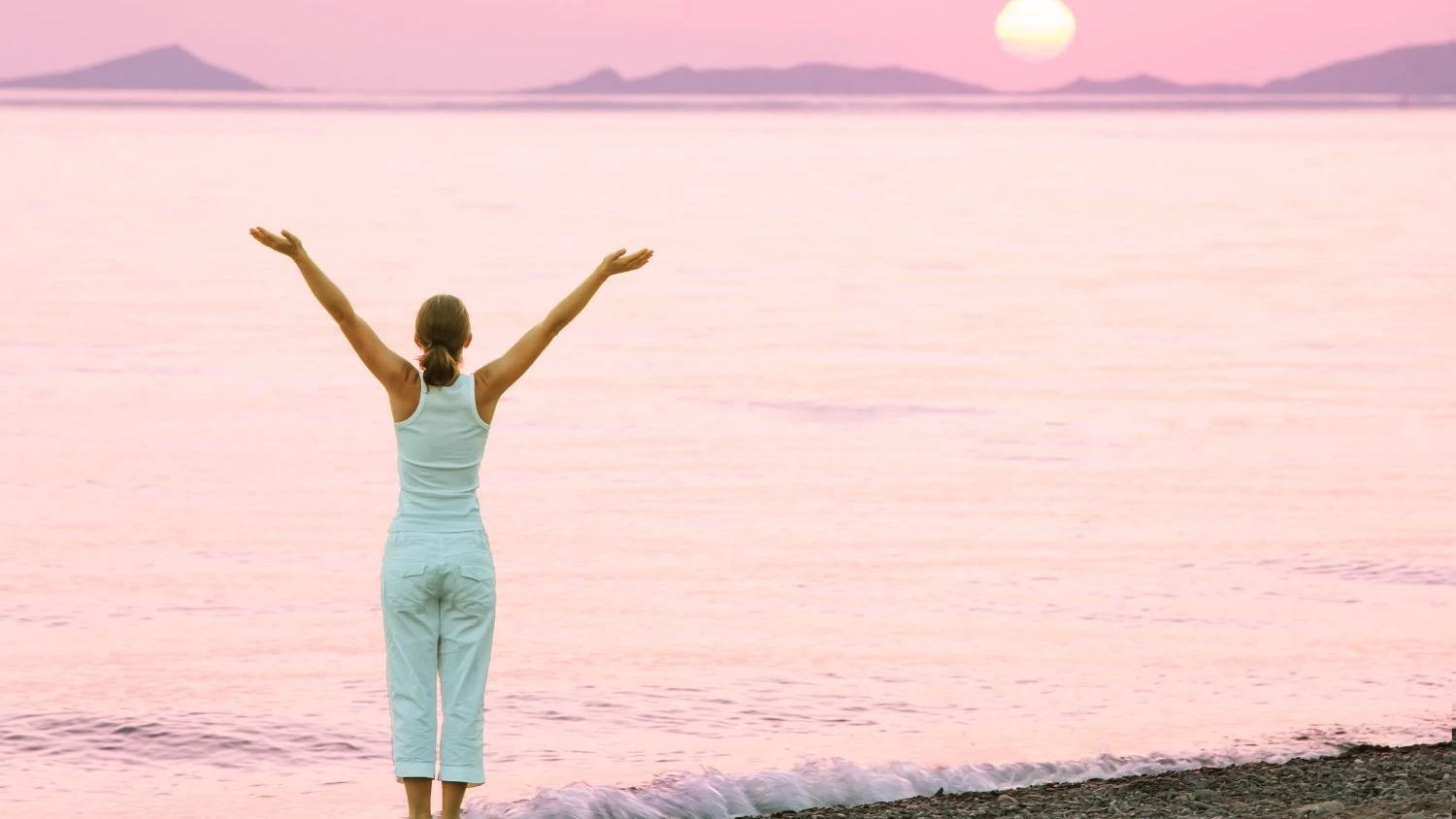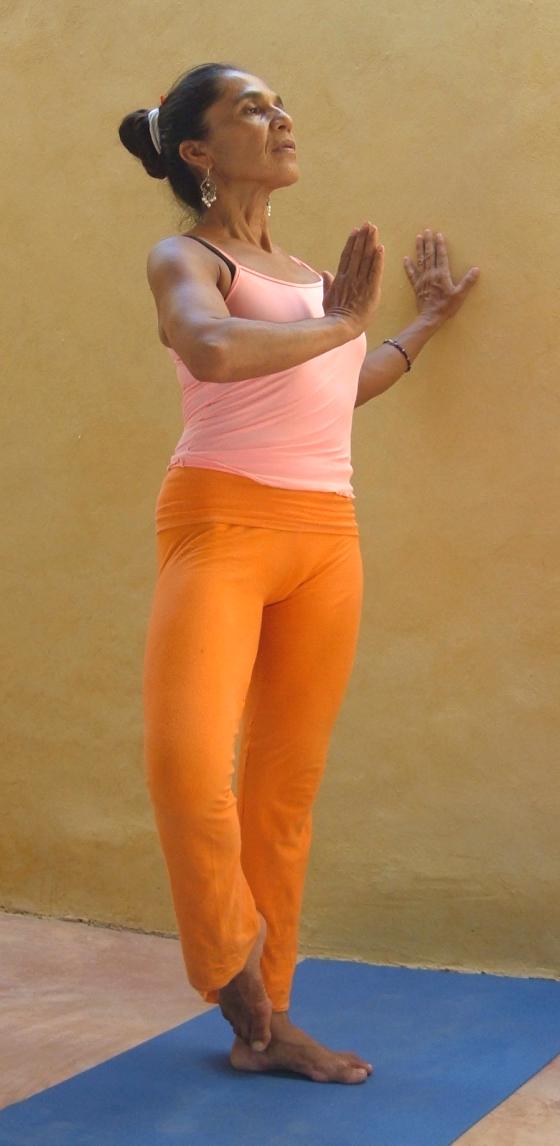Balancing Yoga Pose Basics

The ability to balance becomes increasingly important as we get older. Falls are the leading cause of injury deaths in older adults, and the most common cause of hospital stays for trauma. Like any body skill, balancing is something that has to be practiced in order to be maintained. In this article, Author Stephanie Pappas shares some tips for getting the most out of balance postures exerpted from her book Yoga at Your Wall.
Balance Pose Basics: : Vrksasana – Tree Pose
Balance postures cultivate awareness and require attentiveness. They establish a harmony between the upward and downward flowing energies in your body. When your mind seems scattered, life feels chaotic, or you have been very busy, you can recuperate and repose with the postures in this section. If you find it difficult to balance on one foot, allow your wall to support you in your discovery of greater levels of steadiness and mastery. As you practice, your appreciation deepens for the subtleties of attaining equilibrium.
While you practice, keep these words in mind: centeredness, presence, stillness, grace, stability, focus, integration, wholeness, acceptance, patience, concentration, attentiveness.
Tree pose is a wonderful balancing pose for beginners as well as more experienced yoga students. Tree Pose is easy to modify to suit students at different levels of practice, and it lays the foundation for improving balance over time by strengthening the thighs, calves, ankles and back and increasing flexibility in hips and groin. Tree Pose is often recommended for people who suffer from sciatica or who have flat feet.
Other benefits and experiences of Tree Pose
- Promotes equanimity and centeredness.
- Increases the feeling of being rooted and grounded in your body.
- Creates physical and mental confidence, and reaffirms your presence on the planet.
Tree Pose at the Wall (Facing Sideways)
One of the best ways to start out with Tree Pose is to use a wall.
First, stand sideways about 2 feet away from the wall. You can also perform this pose with your back side slightly touching the wall.
Let your hand touch the wall as you explore your balance on one foot. Focus your eyes on a point in front of you at eye level.
 Strengthen your standing leg (the one closest to the wall) firm like a tree trunk. With the other leg, press your toes on the floor turn your knee out to the side.
Strengthen your standing leg (the one closest to the wall) firm like a tree trunk. With the other leg, press your toes on the floor turn your knee out to the side.
Next, bring your foot up to the ankle area (Figure 1).
General pointers:
Keep your hips parallel to the floor as you turn your leg further out to the side.
Draw your navel toward your spine, tucking your hips, to achieve a neutral pelvic position.
Lift your rib cage and chest. Think of a string suspended from the ceiling, tied to the bottom of your sternum, drawing your chest upward.
Look at a point eye level in front of you, or on the floor 10 to 15 feet in front of you.
Repeat the pose on the other side of your body.
 Stage 2.
Stage 2.
When you are feeling more balanced, press your foot on your shin or upper thigh of your standing leg. (Caution: Do not press your foot into the side of your knee joint.)
Hold your arms in front of your chest in prayer pose. You can also raise your arms overhead in a wide open “V” position or clasped over your head with your index fingers extended.
Repose in the pose and seek balance. Remember, you can return your hand to the wall any time lose your balance.
Repeat the pose on the other side of your body.
Imagery for alignment
Visualize roots growing from the bottom of your feet deep into the Earth and gathering energy from the nutrients and water beneath you. With each exhalation let gravity anchor you more.
As you inhale, feel the lightness and flexibility of your upper body like delicate aspen branches whispering in the wind. Extend yourself and grow tall toward the sunlight that nourishes you.
“Home Play” experiments—exploring and deepening the posture
Feel the subtle movements and micro adjustments of your foot and ankle as you play with your balance.
Sometimes we have a tendency to hold our breath when we are concentrating too much. Pay close attention to your breath to catch yourself when you stop breathing, and begin again.
Once you are established in the pose, close your eyes and notice what it feels like to attempt to balance without a visual reference point. Let yourself yield to the feeling of being off balance. Don’t try to control it!
Precautions
To prevent knee strain, keep your big toe and knee pointing in the same direction. Do not press your foot into the side of your knee area.
Variations
You can also try to do this pose with your knee touching the wall as an aid to balance
Chose an arm position: prayer position in the center of your chest, lifted in a wide “V” position, or extended directly above your head with fingers interlaced and index fingers extended. Remember, you can return your hand to the wall any time lose your balance.
Copyright © 2009, Stephanie Pappas. All rights reserved.



